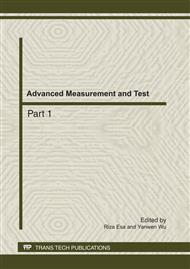[1]
Hafner, J. H,; Cheung, C. -L.; Wooley, A. T.; Lieber, C. M.; Structural and Functional Imaging With Carbon Nanotube AFM Probes, Prog. Biophys. Mol. Biol. 2001, 77, pp.73-110.
DOI: 10.1016/b978-008044031-6/50037-9
Google Scholar
[2]
EW Wong, PE Sheehan, CM Lieber, Nanobeam mechanics: Elasticity, strength, and toughness of nanorode and nanotubes, Science, 1997, 277, p.1971-(1975).
DOI: 10.1126/science.277.5334.1971
Google Scholar
[3]
Iijima S.; Helical microtubes of graphitic carbon, Nature, 1991, 354, pp.56-58.
Google Scholar
[4]
H. Dai, J.H. Hafner, A.G. Rinzler, D.T. Colbert, R.E. Smalley, Nature 384(1996) 147.
Google Scholar
[5]
LU J P. Elastic properties of single and multilayered nanotubes[J]. Phys Rev Lett, 1997, 79, pp.1297-1300.
Google Scholar
[6]
E.S. Snow, P.M. Campbell, J.P. Novak, Appl. Phys. Lett. 80 (2002) (2002).
Google Scholar
[7]
Dubourg, F.; Aime¡ä, J. P. Surf. Sci. 2000, 466, 137.
Google Scholar
[8]
Lee, S. I.; Howell, S. W.; Raman, A.; Reifenberger, R.; Nguyen, C. V.; Meyyappan, M. Nanotechnology 2004, 15, 416.
Google Scholar
[9]
Shapiro, I. R.; Solares, S. D.; Esplandiu, M. J.; Wade, L. A.; Goddard,W. A.; Collier, C. P. J. Phys. Chem. B 2004, 108, 13613.
Google Scholar
[10]
Solares, S. D.; Matsuda, Y.; Goddard, W. A., III. J. Phys. Chem. B 2005, 109, 16658.
Google Scholar
[11]
Solares, S. D.; Esplandiu, M. J.; Goddard, W. A.; Collier, C. P. J. Phys. Chem. B 2005, 109, 11493.
Google Scholar
[12]
A. Kutana, K. P. Giapis, J.Y. Chen, and C. P. Collier, Amplitude response of single-wall carbon nanotube probes during tapping atomic force microscopy modeling and experiment, Nano letters, 2006, Vol. 6, No. 8, 1669-1673.
DOI: 10.1021/nl060831o
Google Scholar
[13]
A. N. Jiang, S. Gao, X. L. Wei, X. L. Liang, and Q. Chen, Amplitude Response of Multiwalled Carbon Nanotube Probe with Controlled Length during Tapping Mode Atomic Force Microscopy, J. Phys. Chem. C 2008, 112, 15631-15636.
DOI: 10.1021/jp804481g
Google Scholar
[14]
Seiji AKITA, Masakaki OHASHI and Yoshikazu NAKAYAMA, Mechanical Properties of Sharpened Carbon Nanotube Tips, Japanese Journal of Applied Physics, Vol. 44, No. 4A, 2005, 1637-1640.
DOI: 10.1143/jjap.44.1637
Google Scholar
[15]
Lennard-Jones, J. E. (1924), On the Determination of Molecular Fields, Proc. R. Soc. Lond. A 106 (738): 463–477.
Google Scholar
[16]
Muhammad A. Hawwa, Hussain M. Al-Qahtani, Nonlinear oscillations of a double-walled carbon nanotube, Computational Materials Science 48 (2010) 140-143.
DOI: 10.1016/j.commatsci.2009.12.020
Google Scholar


